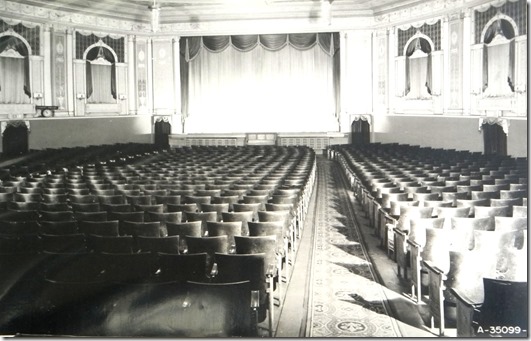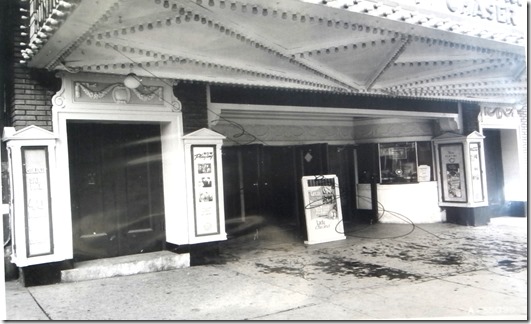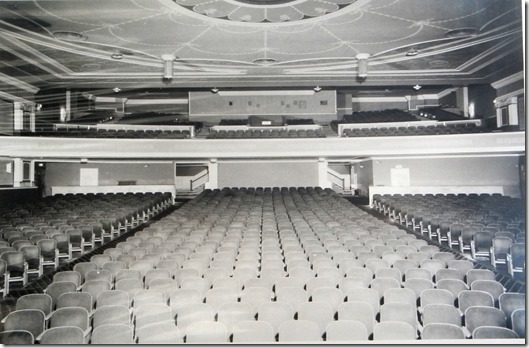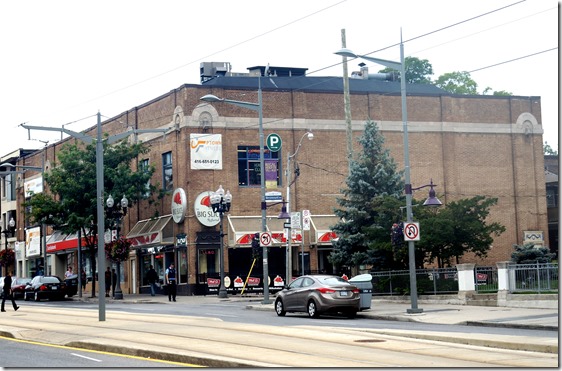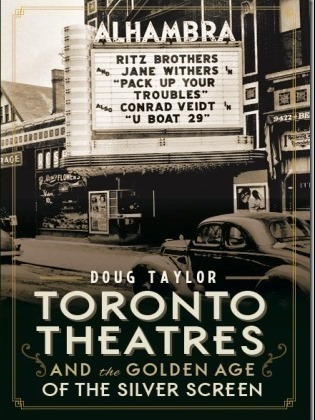The St. Clair Theatre c. 1950. City of Toronto Archives, Series 2182
The St. Clair Theatre, at 1154-1156 St. Clair Avenue West, was a few doors east of the intersection of Dufferin Street and St. Clair Avenue West. I first caught a glimpse of this movie house in the early-1940s, when I was a child and accompanied my mother when she went shopping on St. Clair. The shops along the avenue were a great attraction for her as the alternative was to travel downtown on a Bay streetcar. For me, the big attraction was the huge German Shepherd in the Bell’s Shoe Store. The dog was featured on the cover of the scribblers given to children who visited the store. On the back cover were copies of the multiplication tables. It was a promotional technique that was highly effective. Today, such advertising gimmicks appear as if they belong in the Mediaeval ages.
Location of the St. Clair Theatre
I also remember my father talking about the St. Clair Theatre. After he immigrated to Toronto in 1921, it was a favourite hangout for him and his six brothers since they were living nearby, on Earlscourt Avenue. On hot summer evenings, they often cruised along St. Clair Avenue, trying to catch the eye of a pretty young woman. If my dad were successful, he invited the gal to attend the St. Clair Theatre. During the show, somehow his arm found its way around her shoulder. Perhaps my grandmother overheard my father’s stories about the theatre and this was one of the reasons she objected to movie theatres, fearing that they promoted promiscuous behaviour.
In 1948, my family began attending a church located near Dufferin and St. Clair and I strolled past the theatre on my way to Sunday school. On these occasions, I remembered my dad’s stories about his youthful indiscretions and longed to be of sufficient age to perform a few of my own. Alas, I was forced to be content with the Sunday school teacher’s version of Sampson and Delilah. I was certain that a film version of this tale would be much more risqué. Unfortunately, when “Sampson and Delilah”was released in January 1950, it was an “adult” film and I was too young to purchase a ticket. In 1953, I saw the film “Salome,” starring Rita Hayworth, and my suspicions about bible stories were confirmed.
The St. Clair Theatre was built by the Allen brothers in 1921. They already owned Allen’s Danforth, Allen’s (Tivoli) at Adelaide and Victoria, Allen’s Bloor (Lee’s Palace) and Allen’s Parkdale (The Parkdale). The architect of the St. Clair was C. Howard Crane, at the time employed by the firm of Hynes, Feldman and Watson. The St. Clair’s yellow-brick facades on the south and east were unadorned, except for decorative stone detailing below the cornices. However, similar to other Allen theatres, the interior was tastefully extravagant, especially the high ceiling with its ornamental plaster trim and classical detailing. The theatre successfully displayed the luxury that Allen patrons expected.
However, in the 1920s the theatre possessed no air conditioning, which was uncomfortable during Toronto’s hot summer days and evenings. When my father said that he had “hot times” in the back rows of the St. Clair Theatre, perhaps I misunderstood what he meant. The St. Clair has the distinction of being the only theatre in the world visited by my grandmother. She saw the movie “Captains Courageous” in it in 1937. She lived to be 96 years old and never again darkened the doors of a theatre. Perhaps my grandfather should have sat with her in the back row and cuddled her during the suspenseful parts of the film. On the other hand, she might have considered this to be “Promiscuous behaviour.”
The theatre was extensively renovated in 1950, when new seats were installed. The popularity of the St. Clair Theatre remained throughout the 1950s, but when television caused attendance to dwindle in the 1960s, the theatre was no longer profitable. The wonderful auditorium the Allen brothers had created was divided into two screening spaces. For a few year, Italian films were shown, but this venture also eventually came to an end. The property along St. Clair had greatly increased in value and developers were anxious to purchase the building. It was sold and the space divided into shops. Fortunately, the building survives to this day, though few would ever guess that it was once a highly popular movie house.
March 15, 1920, streetcar on St. Clair, with Allen’s St. Clair Theatre visible in the background. City of Toronto Archives, Fonds 1251, file 231, It. 0226
Auditorium of the St. Clair, Ontario Archives AO 2178
Canopy and marquee of the St. Clair, with the entrance and box office visible. Ontario Archives AO 2181
View of the auditorium from the stage area, revealing the magnificent ceiling and the large balcony. Ontario Archives, AO 2179
The site of the former St. Clair Theatre during the summer of 2014.
To view the Home Page for this blog: https://tayloronhistory.com/
To view previous blogs about movie houses of Toronto—historic and modern
Recent publication entitled “Toronto’s Theatres and the Golden Age of the Silver Screen,” by the author of this blog. The publication explores 50 of Toronto’s old theatres and contains over 80 archival photographs of the facades, marquees and interiors of the theatres. It relates anecdotes and stories of the author and others who experienced these grand old movie houses.
To place an order for this book:
Book also available in Chapter/Indigo, the Bell Lightbox Book Store and by phoning University of Toronto Press, Distribution: 416-667-7791
Theatres Included in the Book:
Chapter One – The Early Years—Nickelodeons and the First Theatres in Toronto
Theatorium (Red Mill) Theatre—Toronto’s First Movie Experience and First Permanent Movie Theatre, Auditorium (Avenue, PIckford), Colonial Theatre (the Bay), the Photodome, Revue Theatre, Picture Palace (Royal George), Big Nickel (National, Rio), Madison Theatre (Midtown, Capri, Eden, Bloor Cinema, Bloor Street Hot Docs), Theatre Without a Name (Pastime, Prince Edward, Fox)
Chapter Two – The Great Movie Palaces – The End of the Nickelodeons
Loew’s Yonge Street (Elgin/Winter Garden), Shea’s Hippodrome, The Allen (Tivoli), Pantages (Imperial, Imperial Six, Ed Mirvish), Loew’s Uptown
Chapter Three – Smaller Theatres in the pre-1920s and 1920s
Oakwood, Broadway, Carlton on Parliament Street, Victory on Yonge Street (Embassy, Astor, Showcase, Federal, New Yorker, Panasonic), Allan’s Danforth (Century, Titania, Music Hall), Parkdale, Alhambra (Baronet, Eve), St. Clair, Standard (Strand, Victory, Golden Harvest), Palace, Bedford (Park), Hudson (Mount Pleasant), Belsize (Crest, Regent), Runnymede
Chapter Four – Theatres During the 1930s, the Great Depression
Grant ,Hollywood, Oriole (Cinema, International Cinema), Eglinton, Casino, Radio City, Paramount, Scarboro, Paradise (Eve’s Paradise), State (Bloordale), Colony, Bellevue (Lux, Elektra, Lido), Kingsway, Pylon (Royal, Golden Princess), Metro
Chapter Five – Theatres in the 1940s – The Second World War and the Post-War Years
University, Odeon Fairlawn, Vaughan, Odeon Danforth, Glendale, Odeon Hyland, Nortown, Willow, Downtown, Odeon Carlton, Donlands, Biltmore, Odeon Humber, Town Cinema
Chapter Six – The 1950s Theatres
Savoy (Coronet), Westwood
Chapter Seven – Cineplex and Multi-screen Complexes
Cineplex Eaton Centre, Cineplex Odeon Varsity, Scotiabank Cineplex, Dundas Square Cineplex, The Bell Lightbox (TIFF)
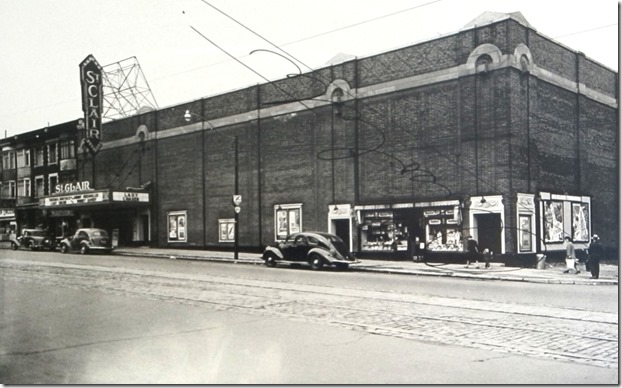
![St. Clair-Dufferin, March 1920 f1231_it0226[1] St. Clair-Dufferin, March 1920 f1231_it0226[1]](https://tayloronhistory.com/wp-content/uploads/2015/03/st-clair-dufferin-march-1920-f1231_it02261_thumb.jpg)
